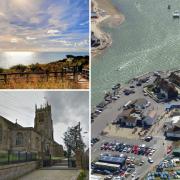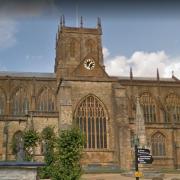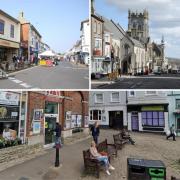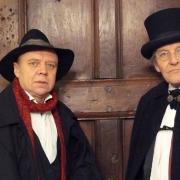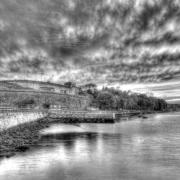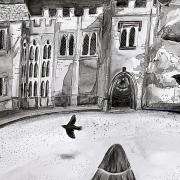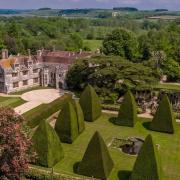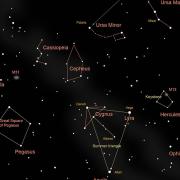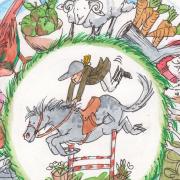Sherborne turns Victorian for the filming of David Nicholls’ adaptation of Far From the Madding Crowd and Boris Starling was on set to see it happen

It’s a drizzly autumn day, and Sherborne hasn’t looked like this for more than a century. Wooden carts piled high with hay and sacks of grain sprawl in front of the Abbey. A tail-coated gentleman tips his top hat to a passing lady while ignoring a beggar’s outstretched hand. Bold printed signs invite punters to come and see ‘Performing Dogs & Monkeys, Ghost Illusions and Real Moving Wax Worx.’ Hawkers shout their wares from brightly-coloured tents: food here, drink there, games everywhere.
There is one still point in all this tumult: a slight, pretty woman in a dark blue dress leaning against a wagon door, a faint smile playing on her face. She is Carey Mulligan, one of Britain’s leading actresses: and today she is Bathsheba Everdene, for this is of course not a time warp but rather the film set of Far From the Madding Crowd.
David Nicholls, the author and screenwriter who has adapted this latest version of Thomas Hardy’s first Wessex novel for the big screen, directed by Thomas Vinterberg, calls Madding Crowd “the lightest, brightest and sunniest of Thomas Hardy’s great works.” Light and sunny are relative terms when it comes to Hardy, of course. Madding Crowd has its fair share of death and disaster as it tells the tale of Bathsheba, the young woman who takes over her uncle’s farm, and of the three very different men who pursue her: decent rural stalwart Gabriel Oak (Matthias Schoenaerts), prosperous but lonely William Boldwood (Michael Sheen) and dashing, dangerous Sergeant Frank Troy (Tom Sturridge).
It is also the first of Hardy’s books to mention Wessex, his ‘partly real, partly dream country.’ Mindful that the luscious Dorset landscape is not just achingly photogenic but also so intrinsic to Hardy’s work, the production team filmed as much as possible in Dorset itself, bringing star quality to the county during the shoot. Sturridge and his fiancée Sienna Miller were spotted out and about in Beaminster – local shopkeeper Richard Barker said “everyone was swooning after Tom. He seemed a very lovely man” - while Michael Sheen was staying just down the road at the Bridge House Hotel.

Location manager Alex Gladstone, whose extensive list of credits includes James Bond’s audience with the Queen during the Olympics opening ceremony, says his first task was to find Bathsheba’s farmhouse. “We chose Mapperton House and sort of dropped anchor there. Then we looked around to find all the other places we needed.”
The eventual list of filming locations reads like the kind of thing the Dorset Tourist Board would suggest as a greatest hits package. There’s architecture: Sherborne Abbey and Sherborne Castle were both taken over for large set-piece scenes. There are rural delights: Hooke Wood and the church at Sydling St Nicholas. And of course there’s the Jurassic Coast: Durdle Door and West Bay can both be seen in the film.
“Hooke Wood was especially amazing,” Gladstone says. “We were looking for a place to film the scene at the ‘hollow-amid-the-ferns’ where Troy dazzles Bathsheba with his swordplay, but everywhere we tried wasn’t quite right. Then someone suggested Hooke Wood: they said it was a place where fairies meet. We looked at each other a bit like ‘yeah right’, but off we went anyway – and the moment we saw it we knew this was it. Hooke Wood really did feel like a place where magic could happen.”

The same scene, though filmed on a hillside rather than in a wood, is perhaps the most iconic moment of the famous 1967 film of Madding Crowd: Terence Stamp seducing Julie Christie and writing them both into Swinging Sixties folklore as he did so. The two films will inevitably be compared, but over coffee in a central London café, Nicholls is adamant that it’s not a competition. “We’ve done our interpretation of the book just as they did theirs,” he says. “But we haven’t remade their film.”
Indeed, where Christie was seen by some reviewers as too sweet and ethereal for the part, Mulligan is a perfect fit: less preternaturally beautiful, perhaps, but far more convincing in portraying Bathsheba as a feisty, independent heroine. The first time we see her, she’s racing through a wood on horseback. “It was just so unheard of for a woman to ride full on like that, switching from side saddle,” says Mulligan. “Then she lies back and lets the tips of the branches touch her.”
Mulligan’s Bathsheba is a passionate woman who makes mistakes – she marries a man who’s in love with someone else, for a start – but she’s also smart and tough enough to get back on her feet after each setback. Mulligan’s face sparkles with amused shrewdness and is almost infinitely malleable. One moment she seems hardly older than a schoolgirl, the next as though she’s about to receive a birthday telegram from the Queen. This kind of contradiction is at the heart of Bathsheba, about whom Hardy himself said ‘though she has too much understanding to be entirely governed by her womanliness, she also has too much womanliness to use her understanding to her best advantage.’
“Oh, yes,” laughs Nicholls. “There’s this notion of 19th-century literature as rather buttoned up, obsessed with form and convention, with doing the right thing. But there’s lots of sex in Hardy. It’s earthy, not courtly. It’s physical, tied in with the landscape and the seasons.”

Nicholls own love affair with Hardy is more than 30 years in the making. “I read Tess Of The D’Urbervilles for A-level, and it had such an effect on me. I found it quite overwhelming.” Tess also provided the inspiration for his novel One Day, which catapulted him to literary superstardom when it was published in 2009 (it has since sold five million copies): in particular, the moment when Tess realises that every year she cycles not only through her birthday but also unknowingly through her death day too, ‘a day which lay sly and unseen among all the other days of the year, giving no sign or sound when she annually passed over it; but not the less surely there.’
In serendipity of which Hardy himself would surely be proud, Nicholls took a break halfway through writing One Day to work on the TV adaptation of Tess itself. “I had four hours’ screen time to work with in Tess but only half that here, so of course a lot had to go. And still you want to give proper time to Bathsheba and the three men – not just for themselves, but because everything she’s offered is a male version of what she should want. As she herself says: ‘it is difficult for a woman to define her feelings in language which is chiefly made by men to express theirs.’”
It’s not hard to see a direct line between Bathsheba and the current vogue for strong female heroines in literature and film – most obviously in The Hunger Games, whose author Suzanne Collins named her protagonist Katniss Everdeen in direct homage to Bathsheba. And then of course there’s Broadchurch: David Tennant’s character being named DI Alec Hardy, the fictional Wessex Police Force, and lingering shots of cliffs and hills bathed in that distinctive soft Dorset light.

But here, the connections run both ways. “When we shot on the beach at West Bay,” Nicholls says, “I kept thinking of it as the Broadchurch beach!” And the riverside cottage where DI Hardy lived in series two of Broadchurch was also where the location manager Alex Gladstone stayed during the filming of Madding Crowd.
DI Hardy might have been put through the wringer during his time there, but Gladstone has nothing but happy memories. “A lot of shoots, you end up dealing with all sorts of problems – bureaucracy, angry residents, that kind of thing. But I can honestly say we didn’t have a single bad moment while filming down here. Everyone was so welcoming and happy to see us. It was a joy from start to finish.”
With thanks to Liz Burt for free access to her image gallery (ideasonfood.co.uk) of filming in Sherborne.
***
READ ON
• Far From The Madding Crowd review - Boris Starling - Far From The Madding Crowd is well worth going to see says Boris Starling...




